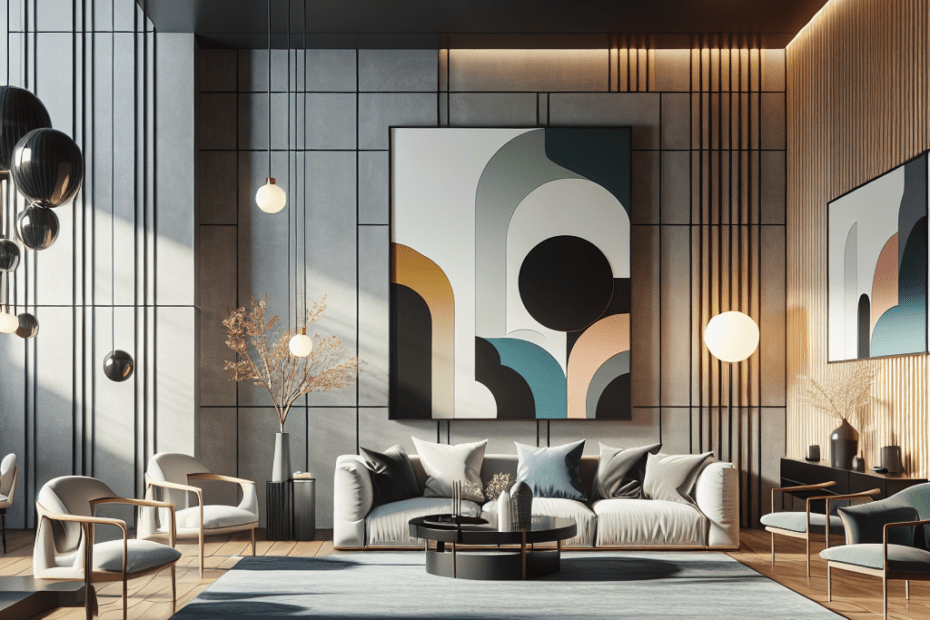“`html
Introduction
Contemporary spaces are ever-evolving, characterized by sleek aesthetics, functional design, and innovative use of color and form. As designers continuously seek ways to infuse these spaces with personality and flair, bold graphic art has emerged as a popular solution. Graphic Art in Contemporary Design is known for its unique ability to enhance both private and public environments, offering a vibrant interplay of colors and patterns that captivates and commands attention. According to Statista, the global art market reached a value of approximately $50.1 billion in 2022, evidencing the growing appreciation for art in everyday spaces.
Creating Dynamic Spaces with Graphic Art
Designers recognize the power of graphic art to transform spaces. The juxtaposition of bold graphics against minimalist backdrops adds interest and depth, making each room feel more dynamic and engaging. They explore how large murals or strategic placements can serve as focal points in sparse rooms, acting almost like a visual anchor that guests and residents naturally gravitate towards.
Techniques and Applications
There are several methods in which designers can incorporate graphic art in contemporary spaces:
- Wall Murals: These can cover entire walls with striking patterns or imagery, providing a dramatic effect that changes the space’s narrative instantly.
- Accent Walls: Similar to murals but often subtler, accent walls utilize bold colors or textures to differentiate sections of a room.
- Art Installations: Three-dimensional or multimedia installations can be used to create unique sensory experiences that play with perception and space.
- Furniture and Fabrics: Incorporating graphic designs into furniture upholstery or textiles allows for a coherent and unified theme throughout the room.
Choosing the Right Piece
When selecting graphic art for contemporary spaces, designers consider the scale, color scheme, and the existing design elements. It is crucial to balance bold pieces with the overall design plan to create harmony rather than overwhelming the viewer. Specialists recommend considering the following:
| Consideration | Tips |
|---|---|
| Scale | Match the art size to the room dimensions, ensuring the piece neither gets lost nor overpowers the space. |
| Color Cohesion | Select pieces that complement or contrast the existing palette for a desired effect. |
| Theme | Ensure that the graphic art aligns with the overall theme of the space for cohesiveness. |
Benefits of Graphic Art in Contemporary Spaces
Embracing graphic art in contemporary design offers several advantages:
- Emotionally Engaging: Bold graphic art can evoke emotions or provoke thought in ways neutral design might not.
- Space Definition: Graphic art can help delineate spaces within an open floor plan, providing visual boundaries.
- Brand Identification: For commercial spaces, graphic art can be a strong tool for brand identification and storytelling.
A study published in the Frontiers in Psychology shows that visual art can significantly impact mood and perceived space size, which is pivotal for cultivating the desired atmosphere in any given room.
Challenges and Considerations
While incorporating graphic art offers multiple benefits, designers must also navigate certain challenges:
- Cost: Quality art can be expensive, and designers need to find solutions within budget constraints.
- Installation: Some art pieces require careful and specific installation instructions, which can incur additional costs and time.
- Maintenance: Depending on the materials used, art pieces may require regular maintenance to preserve their look.
Key Takeaways
- Graphic Art in Contemporary Design is a growing trend, offering a unique way to breathe life into modern spaces.
- Successful integration of graphic art involves careful consideration of scale, color, theme, and balance.
- Graphic art can provide emotional engagement, space definition, and brand identification.
- While there are challenges, the impact on mood and room aesthetics makes graphic art a valuable element in contemporary design.
FAQ
- What is considered graphic art?
Graphic art includes works that involve design elements like line, shape, and color, often seen in illustrations, digital art, and typography. - How does graphic art impact a contemporary space’s mood?
Graphic art can evoke specific emotions, set a tone, or even alter the perception of the space’s size, thus significantly impacting the mood. - Is graphic art suitable for small spaces?
Yes, when appropriately scaled and chosen to complement the existing decor, graphic art can enrich small spaces without overwhelming them. - Can graphic art be used in commercial spaces?
Absolutely. It’s often employed to reinforce brand identity, create memorable experiences, and define spaces within commercial settings. - What should be considered when maintaining graphic art?
Regular dusting, avoiding direct sunlight, and using conservation-friendly materials and methods can help preserve the quality of graphic art over time.
“`
